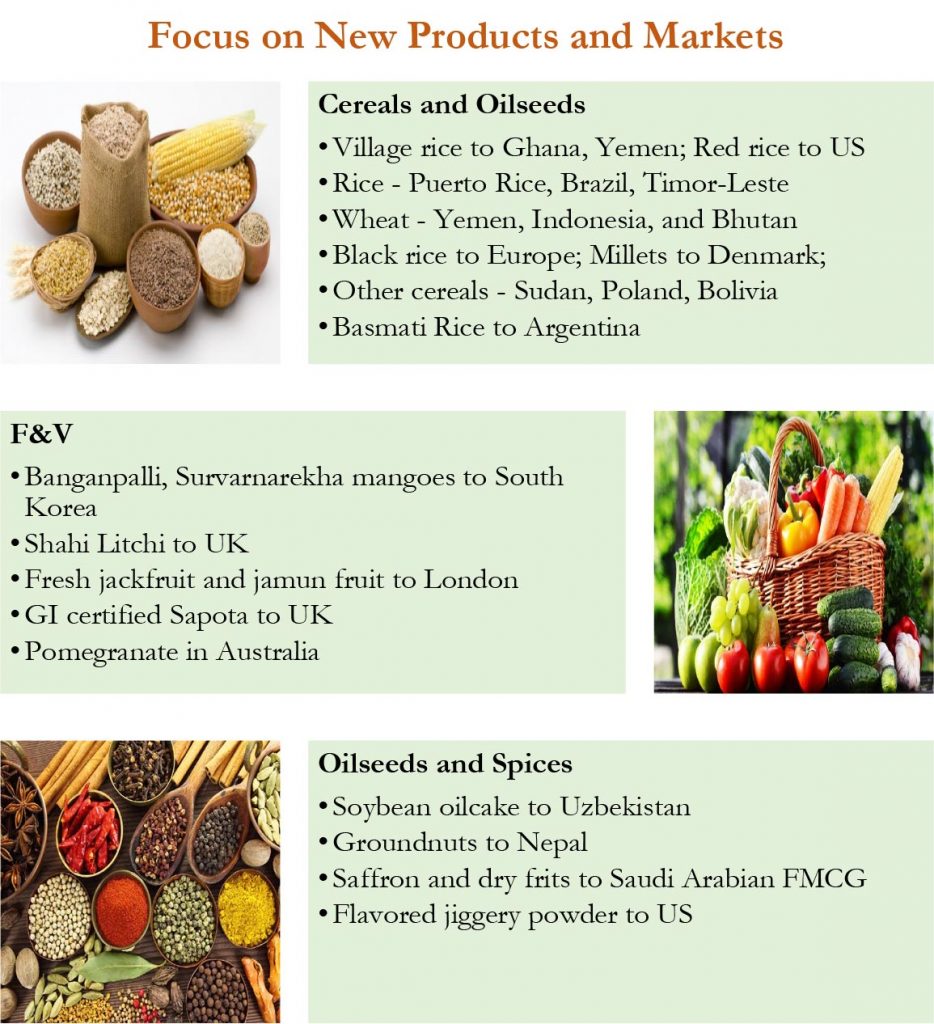
3600 Approach Unfolding Umpteen Opportunities in Agri Exports
Despite the COVID-19 pandemic, Indian agriculture witnessed colossal growth in agri exports, during the last fiscal year. Consistent government endeavors, reforms, and programs arising from policy changes coupled with opportunities that emerged out of COVID -19 have triggered the growth. After facing stagnancy and decline since 2017, agri exports reached USD 41.25 billion in 2020 – 21 as against USD 35.16 billion in 2019 – 20, observing a growth of 17.34 percent. India adopted a multitude of different approaches that elicited this growth. Measures taken during the COVID-19 pandemic ensured uninterrupted exports and changing dynamics of international markets boosted agri exports. Certain relaxations allowed by the government during the pandemic also helped in the growth including spice board exemptions for mandatory testing of samples with labs being shut down due to lockdown, promotion of rapid tests in place of lab tests.
The export of cereals and millets, spices and condiments, tea, medicinal plant products, dry fruits, and sugar grew 51 per cent to USD 1.04 billion over last year. The rise in the export of cereals is boosted by 774.17% growth in wheat export, 136.04% in non-basmati rice, and 238.28% in other cereals. India reached its highest ever level of spice export worth USD 4 billion. Due to the pandemic outbreak and increasing demand for organic products, organic product exports grew by 50.94%. Bangladesh, China, Indonesia, Iran, Malaysia, Nepal, Saudi Arabia, the UAE, and Vietnam are the largest Agri export markets. Among these, Indonesia (102.42%), Bangladesh (95.93%), and Nepal (50.49%) recorded the highest growth. Expanded port-handling capacity helped India achieve about 45% of global rice exports by shipping higher volumes across Africa and Asia.
The central governments’ efforts of implementing Agriculture export policy (AEP) across strategic districts showed success. The AEP, announced in 2018, focuses on export-oriented agri production and promotion, better farmer realization, and synchronization with other national policies and programs. The government has been focusing on diversifying and  expanding the export basket of agricultural products by promoting products unique to the country. Market development strategy concentrated on identifying top 10 products and 20 potential products from the sector for exports. Focusing on new products and newer markets has helped attain growth (See Figure). Country-wise agri export strategies have been developed to identify products, their potential, and the way forward for each country. The state-driven AEP has improved farmer returns and triggered the adoption of better farming practices due to requirements for catering to the international markets.
expanding the export basket of agricultural products by promoting products unique to the country. Market development strategy concentrated on identifying top 10 products and 20 potential products from the sector for exports. Focusing on new products and newer markets has helped attain growth (See Figure). Country-wise agri export strategies have been developed to identify products, their potential, and the way forward for each country. The state-driven AEP has improved farmer returns and triggered the adoption of better farming practices due to requirements for catering to the international markets.
The farmer-centric and cluster-based approach of AEP gave Farmer Producer Organizations (FPO’s) and farmers a stake in the export of their produce. As a part of the cluster-based approach, 46 unique product-district clusters were formed for export promotion. These clusters were created by forming cluster-level committees, FPO’s, connections exporters to FPOs, and sorting out transportation and logistics issues. Some of the key clusters include Lucknow cluster (Mango), Varanasi cluster (fruits and vegetables), Nagpur cluster (orange), Anantapur cluster (banana), etc. Export of 5 products (saffron, ginger, turmeric, coriander, cumin) from 26 districts have been promoted under the One District One Product (ODOP) scheme. Direct involvement of farmers is further encouraged by the government for promoting exports. Opportunities are opening and potential have been created for exporting organic mango, pomegranate, litchi, pineapple, banana okra and green chillies, ginger, turmeric and seasame to UK, Netherlands, Germany, France, USA and Japan. Around 2360 FPOs/FPCs and 2324 exporters have been registered in the Farmer Connect Portal set up by APEDA, providing them with a platform to interact with the exporters.
Among other measures adopted, digital platforms have been set up for tracking traceability of the product to the farm level (HortiNet – Mango, Vegetables, Citrus fruits; Basmati.Net; TraceNet, Peanut.Net; Meat.Net; Farmer Registration App, etc.). Different Ministries have promoted numerous schemes and programs to address transport and logistics issues – Kisan Rail service and Operations Green – TOP to Total (subsidy of 50% on transportation of F&V via Kisan Rail). Kisan Rath Mobile Application facilitates enables farmers/FPOs/traders to load requests for transportation to aggregators and transporters. Krishi Udaan Scheme helps farmers to improve their value realization, especially in northeastern and tribal districts. Diversified efforts are being made with various countries to connect exporters, and importers like Virtual buyer-seller meets. Market intelligence cell has been set up to disseminate market intelligence reports and availing opportunities for exports. Stringent and mandatory testing of basmati rice exports (key traditional export product) by Export Inspection Council (EIC) for specific chemicals have decreased the number of alerts of failing to meet export standards.
The government’s holistic efforts have opened up new avenues in Indian agricultural exports. The integration with synergic and suitable private sector solutions hold the potential to increase farmers’ profits. The comprehensive measures adopted opens up opportunities for enhancing exports to premium markets of US and EU for key products. In addition, this is also expected to bring the paradigm shift in field-level agricultural practices, thereby creating a place of strategic crops in the international platform.
Author:

Connect with Authors at: E-mail agribusiness@sathguru.com
 Grow Beyond
Grow Beyond 

